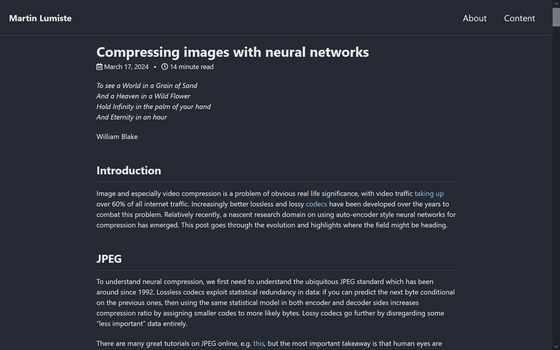To what extent is image compression using neural networks such as AI becoming a reality?

Compressing the file size of images and videos leads to reducing Internet traffic, so many engineers are reconsidering compression technology. Martin Lumiste, who works on the development of real-time video compression technology at Microsoft, explained how far compression methods using ``neural networks'', which were born after several technological developments, will have evolved as of 2024.
Compressing images with neural networks | Martin Lumiste

In order to understand ``neural compression'', a compression method using neural networks, it is first necessary to understand the compression format ``JPEG'', which has been in existence since 1992.
The JPEG compression method reduces the file size by reducing the quality of a portion of the image by 'removing details.' Specifically, the image is divided into blocks of 8 pixels x 8 pixels, and the fineness of the texture is converted into frequency. After conversion, the size is compressed by removing the more textured high frequency bands and leaving only the low frequency bands.

According to Mr. Lumiste, ``The human eye accepts rough changes much more easily than subtle changes in texture,'' which makes it possible to compress images while minimizing the sense of discomfort using the JPEG method. that's right.
A technology that appeared later is neural compression, which parameterizes this method of converting image data into frequencies (discrete cosine transformation) and leaves the calculation to a neural network. Johannes Barre and his colleagues, who first published a model with similar functionality in 2018, showed that the method achieved better compression rates than JPEG, giving hope to research into compression methods.

For neural compression, a method using a machine learning model that performs 'weighting' to select important data has been developed, and compression using a trained model has shown better benchmarks than conventional ones for several codecs. That's what he said. However, the bottleneck is the computational cost of machine learning, and considering the cost, it seems that it still cannot be said to be superior to conventional codecs.
In addition, hybrid approaches that combine traditional codecs and neural networks have appeared in video compression, but cutting-edge codecs that do not use machine learning are said to be more powerful.
'This may mean that, at least for the time being, a lighter-weight hybrid neural approach is the best way to enhance image and video compression,' Lumiste said. There is also a high possibility that neural codecs that operate on highly general-purpose neural hardware will become dominant.

Related Posts:
in Posted by log1p_kr







